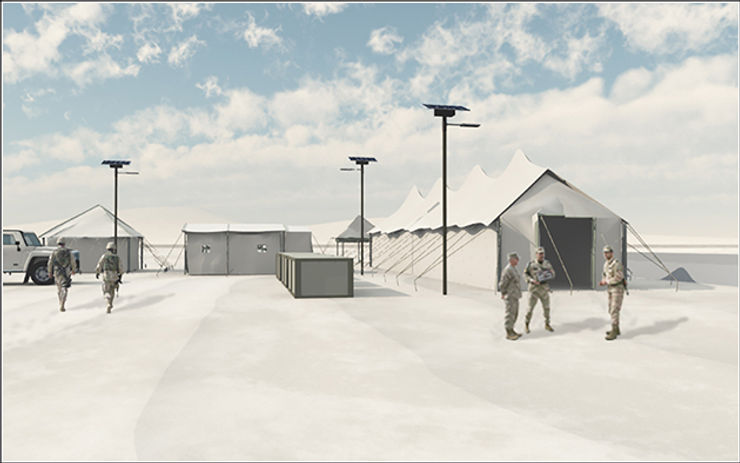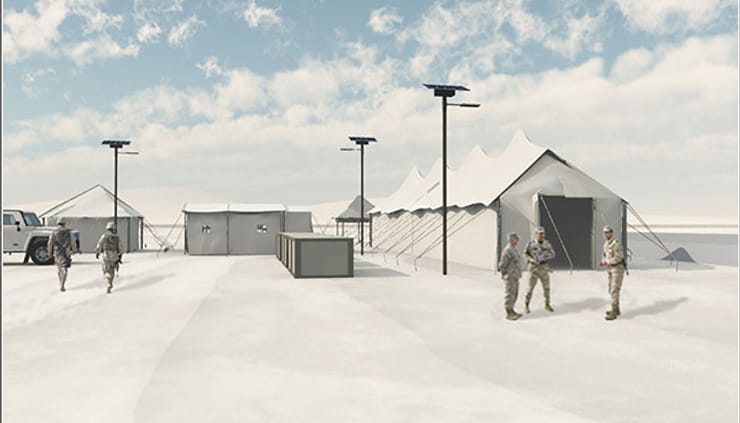Military Base solar street light Solutions and Design guide
Best Solar Military Base Lighting Solutions
In modern military bases, reliable, efficient, and economical lighting solutions are crucial. Solar lighting systems are increasingly becoming the preferred choice due to their environment-friendly and low-maintenance characteristics. Below are the best solar military base lighting solutions to meet your needs.
 System Components
System Components
1.1 Solar Panels
- Reason for Selection: High-efficiency monocrystalline solar panels with an efficiency of over 20% ensure maximum energy utilization.
- Configuration: Each light is equipped with a 200Wp monocrystalline solar panel, output voltage is 24V. The number of solar panels is arranged reasonably based on the size of the base and lighting conditions.
- Installation Angle: The installation angle is adjusted based on the local latitude; in Xisha Islands, the optimal angle is about 20° to maximize solar energy reception.
1.2 Batteries
- Reason for Selection: Lithium-ion batteries have a long cycle life and low maintenance costs, capable of stable operation in extreme environments.
- Configuration: Each light is equipped with a 24V/200AH lithium-ion battery, ensuring normal operation for 7 consecutive rainy days.
- Charge and Discharge Management: Smart charge controllers with overcharge, over-discharge protection, temperature compensation, and auto-recovery features extend battery life.
1.3 LED Lights
- Reason for Selection: High-efficiency LED lights ensure excellent lighting effects while being energy-efficient.
- Configuration: Each light utilizes a 100W LED with an output of 10,000 lumens, color temperature set between 5000K and 6000K, and a color rendering index (CRI) of no less than 80.
- Placement: Light pole spacing is designed as 30m for main roads, 40m for secondary roads, and 50m for living areas to ensure adequate illumination.
1.4 Control Systems
- Time Detection: The system automatically detects the current time, turning on the lights from 7:00 PM to midnight, entering sleep mode from midnight to 6:00 AM, and recharging from 7:00 AM to 5:00 PM.
- Light Intensity Detection: The system checks if the solar panel voltage exceeds the battery voltage to manage charging effectively.
- Remote Monitoring: Leveraging IoT technology allows for remote monitoring and maintenance to promptly address issues, reducing upkeep costs.
- Safety Features: The system provides protections against lightning, strong winds, and dust, ensuring proper functioning in harsh environments.
2. Key Lighting Parameters
2.1 Lumens (lm)
- Main Roads: Average lumens should be at least 10,000lm.
- Secondary Roads: Average lumens should be at least 7,000lm.
- Living Areas: Average lumens should be at least 5,000lm.
- Special Areas: Such as command centers and guard posts should have an average of at least 12,000lm.
2.2 Luminous Efficacy
- LED Lights: Generally above 150lm/W.
- Fluorescent Lights: Around 80lm/W.
- Incandescent Lights: About 20lm/W.
2.3 Uniformity
- Main Roads: Uniformity should be at least 0.4.
- Secondary Roads: Uniformity should be at least 0.35.
- Living Areas: Uniformity should be at least 0.3.
- Special Areas: Uniformity for command centers and guard posts should be at least 0.5.
2.4 Color Temperature
- Main and Secondary Roads: Suggested color temperature between 5000K and 6000K.
- Living Areas: Suggested color temperature between 4000K and 5000K for a comfortable lighting environment.
- Special Areas: Suggested color temperature between 6000K and 7000K for enhanced visual clarity.
2.5 Color Rendering Index (CRI)
- Main and Secondary Roads: CRI should be at least 80.
- Living Areas: CRI should be at least 70.
- Special Areas: CRI should be at least 85.
3. System Design and Optimization
3.1 Solar Panel Installation
- Location: Choose unobstructed areas around the base or at the top of light poles.
- Angle: Optimize installation angles based on local latitudes for maximum solar reception.
3.2 Light Pole Height and Spacing
- Height: Main road poles should be 10m, secondary roads 8m, and living areas 6m.
- Spacing: Main roads 30m, secondary roads 40m, and living areas 50m.
3.3 Control System Optimization
- Smart Management: Ensure batteries operate in optimal conditions to extend lifespan.
- Automatic Adjustment: Lights automatically adjust brightness based on weather and lighting conditions.
4. Application of Integrated Solar Cameras and Lights
4.1 Installation Recommendations
It is recommended to install integrated solar cameras and lights at the base entrance, exit, critical intersections, and key areas to ensure effective monitoring and enhance safety.
4.2 Key Features
- HD Cameras: 1080p resolution with night vision capabilities ensure clarity even at night.
- Communication Modules: Built-in GPRS or 4G modules enable real-time data transmission.
- Smart Control: Integrated control systems for both cameras and lights support remote monitoring and adjustments.
- Weather Resistant: Designed to withstand extreme conditions with features like anti-lightning, anti-wind, and water/dust proof (IP67).
5. Suggested Conditions and Recommendations
5.1 Areas with Abundant Sunlight
Choose a purely solar lighting system, ideal for regions like southern China and Middle Eastern deserts due to simplicity, low maintenance, and energy efficiency.
5.2 Areas with Moderate Sunlight
Opt for a solar and grid-mixed power system, offering dual assurance in regions like northern China and central Europe, with high reliability and adaptability.
5.3 Areas with Abundant Wind and Solar Energy
Choose a hybrid solar and wind power system to maximize natural resource utilization, suitable for regions like western highlands and coastal areas in China, as well as North American plains.
6. Case Studies
6.1 Xisha Islands Military Base (China)
- Background: Located in a tropical region with long sunlight hours but occasional heavy rain, requiring reliable lighting and monitoring.
- System Configuration: Equipped with 200Wp solar panels, 24V/200AH lithium batteries, and 100W LEDs producing 10,000 lumens.
- Outcomes: Maintained 10,000 lumens, ensuring effective lighting, achieving uniformity over 0.4, and providing stable operation even during continuous rain.
6.2 Fort Bliss Military Base (United States)
- Background: Located in Texas with good sunlight conditions but subject to extreme weather, requiring stable lighting and monitoring.
- System Configuration: Similar to Xisha, leveraging solar panels, lithium batteries, and LED lights for efficient operation.
- Outcomes: Ensure 10,000 lumens for adequate lighting and stable performance under varying conditions.
7. Things We Are Currently Doing and Optimizing
7.1 Intelligent Control
We are integrating IoT technology for remote online monitoring and intelligent adjustments, enhancing system reliability and efficiency by monitoring lighting conditions and battery status in real-time.
7.2 Multi-Functional Integration
We are working towards integrating additional functionalities such as surveillance cameras and communication modules with the solar lighting system to enhance overall service levels.
7.3 Application of New Materials
We are applying innovative materials to improve the efficiency and lifespan of solar panels, while also reducing overall system costs with advanced storage technologies.
7.4 Ongoing System Optimization
We value user feedback to continually monitor and evaluate existing systems, optimizing configurations for superior lighting and monitoring effectiveness across different environments.
Through these comprehensive design guidelines and solutions, we ensure our solar military base lighting systems deliver high performance, reliability, and economic benefits. Our solutions not only comply with international lighting standards but also provide stable illumination under various conditions, ensuring nighttime safety while promoting energy efficiency.





